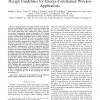Free Online Productivity Tools
i2Speak
i2Symbol
i2OCR
iTex2Img
iWeb2Print
iWeb2Shot
i2Type
iPdf2Split
iPdf2Merge
i2Bopomofo
i2Arabic
i2Style
i2Image
i2PDF
iLatex2Rtf
Sci2ools
COMSUR
2016
2016
20 Years of Turbo Coding and Energy-Aware Design Guidelines for Energy-Constrained Wireless Applications
—During the last two decades, wireless communication has been revolutionized by near-capacity Error-Correcting Codes (ECCs), such as Turbo Codes (TCs), which offer a lower Bit Error Ratio (BER) than their predecessors, without requiring an increased transmission Energy Consumption (EC). Hence, TCs have found widespread employment in spectrum-constrained wireless communication applications, such as cellular telephony, Wireless Local Area Network (WLAN) and broadcast systems. Recently however, TCs have also been considered for energyconstrained wireless communication applications, such as Wireless Sensor Networks (WSNs) and the ‘Internet of Things’ (IoT). In these applications, TCs may also be employed for reducing the required transmission EC, instead of improving the BER. However, TCs have relatively high computational complexities and hence the associated signal-processing-related ECs are not insignificant. Therefore, when parameterizing TCs for employment in energy-constrained...
| Added | 31 Mar 2016 |
| Updated | 31 Mar 2016 |
| Type | Journal |
| Year | 2016 |
| Where | COMSUR |
| Authors | Matthew F. Brejza, Liang Li, Robert G. Maunder, Bashir M. Al-Hashimi, Claude Berrou, Lajos Hanzo |
Comments (0)

